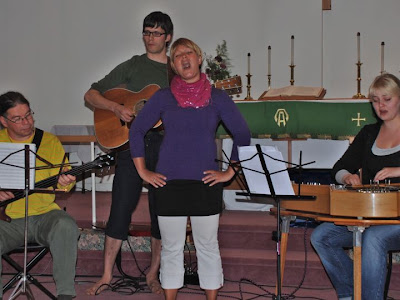
The Maine-based organization
Kantele Laulu was started several years ago to promote Finnish music and culture in general, with a particular emphasis on the national instrument of Finland, the kantele. A harp-like instrument made in several different sizes and shapes, the kantele has existed for at least two thousand years and is featured prominently in the Finnish national epic poem the Kalevala. Part of Kantele Laulu's activities involve a performing group called The Maine Kanteles, who give concerts around Maine and in some nearby states. Founding member Sarah Cummings-Ridge, a schoolteacher of Finnish descent, wanted to expand the reach of the organization to people interested in Finnish music beyond the immediate vicinity. So in 2003, Kantele Laulu put on the first Maine Kantele Institute. Bringing in people from across the United Sates and Canada, this gathering combined instruction and performance on the kantele with a building workshop where people could build their own kantele with the help of a prominent Finnish luthier. While similarly structured workshops and camps exist in the United States for the music and dances of other Scandinavian countries, the MKI was the first American camp devoted specifically to instruction in the musical traditions of Finland. For the second MKI in 2004, group instruction in the Finnish pelimanni (group playing, traditionally involving several fiddlers and maybe one or two accompanists) tradition was added. The MKI first came to my attention that year; the pelimanni instruction made me curious enough to make the trip, and I wound up having a great time. A shortage of grant money put the Institute on hiatus for a few years, but happily the MKI returned last month, with four instructors and approximately 20 attendees.
St. Matthew's Episcopal Church
The primary difference between this edition of the MKI and the previous one was the change of location. It had gotten too expensive to hold it along the waterfront in South Portland, and this time around it was held further inland at
St. Matthew's Episcopal Church in Lisbon Falls. Three of the four teachers remained the same.
Vilma Timonen is a professional singer and kantele player.
Topi Korhohen, who taught guitar and pelimanni class, has been a guest musician with the excellent Finnish/Norwegian folk band Frigg.
Erkki Okkonen is an accomplished bassist, but is better known for his instrument-making skills. The new instructor was
Anna-Karin Korhonen, who also taught kantele.
The first night performance (photo by Paul Taras)
The MKI convened on Sunday, August 3. The primary function of the first day was to arrive, greet everybody, and get acquainted with the location. I got to touch base with a number of people that I met four years ago, but there were plenty of new faces as well. Sunday evening featured a short performance put on by the four instructors. Most of the performance predictably revolved around the kantele, but Vilma is a really good singer as well, and Topi and Erkki are first-rate musicians. They had to compete with a thunderstorm outside however. Rain would be a frequently recurring theme throughout the week.
The classes started on Monday. Lessons ran in different rooms of the church from 9 to 5, Monday through Friday. In addition to kantele instruction at several different levels of difficulty, there were two pelimanni groups, a singing and dancing course, and plenty of private instruction. I took a beginner's kantele course with Anna-Karin; I figured that since I went through the trouble of building a kantele last time, I should also go through the trouble of actually learning how to play it. I also played guitar and bouzouki in the one of Topi's pelimanni sessions. Like last time we lacked any fiddlers, but we still managed well enough. We had one other guitarist, a kantele, an accordion, and two professional-caliber flute players. We had no fiddlers, who dominate typical Finnish pelimanni groups, but we still had a pretty good balance of instruments. I also got some one-on-one guitar lessons with Topi, and picked up a few new tunes and some new ways to play chords as well.
Instrument builders hard at work
Each attendee had gaps between courses, allowing time to practice, to explore, or for many of us, to go to the "building building" and work on their new instruments under Erkki's guidance. Many kanteles of different sizes were built, but two intrepid people instead built jouhikkos for themselves. (The jouhikko is a very old fiddle-like instrument peculiar to Finland and Karelia.) I didn't see the need to build another instrument this time around, so I mostly practiced in my spare time, and took walks when the weather actually allowed. I also got to her the singing group practice in the main part of the church. They always sounded really good.
Chris and Tooty in the kitchen (photo by Paul Taras)
Lunch, dinner, and snacks were provided by Chris Frazier and Tooty Wilson, two members of the Maine Kanteles. They spent most of the week in the church kitchen cooking and preparing food. We ate like kings all week, and all of us who were there are very grateful for their efforts. The culinary highlight came on Tuesday, when the Finns were treated to their first Thanksgiving dinner, complete with turkey and all the trimmings. Lunch and dinner were communal affairs, and provided everybody with the best opportunities to socialize.
For the first three days of the week, dinner was followed by a discussion. The topics ranged from the history of the kantele and it's role in the Kalevala to the art of instrument building. Thursday night was much less serious, though. It's a custom in Finnish music camps to reserve a night for "Hupi Ilta" (literally "fun night"), which consists of a series of comedy sketches conceived and performed by both the students and the instructors, and the MKI has brought this custom over here. The evening was quite silly and entertaining. Highlights included a parody of the Olympics in which everybody participated, and the four instructors doing a hilarious song describing the week's activities.
From the Friday night concert (photo by Paul Taras)
On Friday night, the church hosted a concert open to the general public. The instructors headlined the show, but the Maine Kanteles played as well. In addition, some of the attendees played what they'd been working on all week. I got to go up with the pelimanni group, and we performed a waltz and a polska. The turnout was pretty good, and the whole show appeared to be well-received.
Topi and myself (photo by Paul Taras)
The musical activities ended on Saturday morning, with performance of everything learned during the week that people didn't get a chance to perform on Friday night. This was not a public show; rather, the attendees performed informally for each other. Along with one more pelimanni piece, I played a pair of guitar duets with Topi. One was a polska played by
Frigg, and the other came from the Danish duo
Haugaard and Høirup.

On Saturday night, we all drove down to Bailey Island on the Atlantic Coast. We visited the
Land's End Gift Shop, and had dinner at
Cook's Lobster House. The Maine coastline is quite beautiful, and the weather mercifully cooperated for the first time all week.It was a good place to do one last bit of socializing and say our goodbyes until next time. I'm not entirely certain when next time will be. It could be next year, it could be longer, depending on things like grant money and how frequently people are willing and able to make the trip. I will say that I've had a blast both times I've gone, and I certainly hope I can do this again.
Sarah Cummings-Ridge, Vilma Timonen, and Anna-Karin Korhonen
 Every Halloween the bookstores get flooded with horror anthologies. While some focus on a particular creature or author, some take a broader theme. My Favorite Horror Story, edited by Mike Baker and Martin H. Greenberg, goes to the experts: The stories are chosen by contemporary horror authors, who also write introductions to each tale.
Every Halloween the bookstores get flooded with horror anthologies. While some focus on a particular creature or author, some take a broader theme. My Favorite Horror Story, edited by Mike Baker and Martin H. Greenberg, goes to the experts: The stories are chosen by contemporary horror authors, who also write introductions to each tale.





























